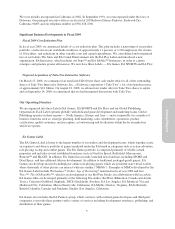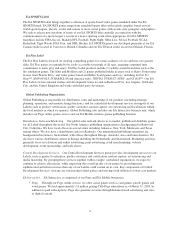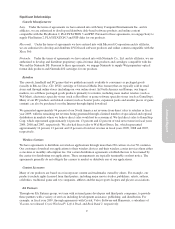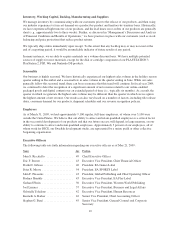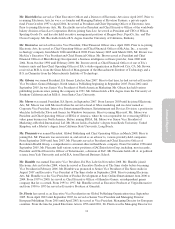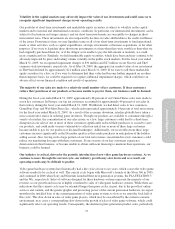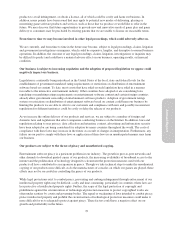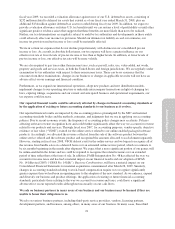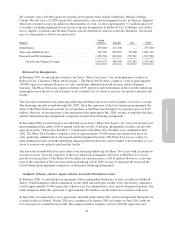Electronic Arts 2009 Annual Report Download - page 95
Download and view the complete annual report
Please find page 95 of the 2009 Electronic Arts annual report below. You can navigate through the pages in the report by either clicking on the pages listed below, or by using the keyword search tool below to find specific information within the annual report.
Annual Report
Volatility in the capital markets may adversely impact the value of our investments and could cause us to
recognize significant impairment charges in our operating results.
Our portfolio of short-term investments and marketable equity securities is subject to volatility in the capital
markets and to national and international economic conditions. In particular, our international investments can be
subject to fluctuations in foreign currency and our short-term investments are susceptible to changes in short-
term interest rates. These investments are also impacted by declines in value attributable to the credit-worthiness
of the issuer. From time to time, we may liquidate some or all of our short-term investments to fund operational
needs or other activities, such as capital expenditures, strategic investments or business acquisitions, or for other
purposes. If we were to liquidate these short-term investments at a time when they were worth less than what we
had originally purchased them for, or if the obligor were unable to pay the full amount at maturity, we could
incur a significant loss. Similarly, we hold marketable equity securities, which have been and may continue to be
adversely impacted by price and trading volume volatility in the public stock markets. For the fiscal year ended
March 31, 2009, we recognized impairment charges of $30 million and $27 million on our Neowiz and The9
common stock investments, respectively. As of May 14, 2009, the aggregate fair market value of our investment
in The9 had declined by approximately $21 million since March 31, 2009. If we were to sell these marketable
equity securities for a loss, or if we were to determine that their value had become further impaired on an other-
than-temporary basis, we could be required to recognize additional impairment charges, which could have an
adverse effect on our financial condition and results of operations.
The majority of our sales are made to a relatively small number of key customers. If these customers
reduce their purchases of our products or become unable to pay for them, our business could be harmed.
During the fiscal year ended March 31, 2009, approximately 68 percent of our United States sales were made to
seven key customers. In Europe, our top ten customers accounted for approximately 44 percent of our sales in
that territory during the fiscal year ended March 31, 2009. Worldwide, we had direct sales to two customers,
GameStop Corp. and Wal-Mart Stores Inc., which each represented approximately 14 percent of total net revenue
for the fiscal year ended March 31, 2009. As a result of the economic downturn, retailers globally have taken a
more conservative stance in ordering game inventory. Though our products are available to consumers through a
variety of retailers, the concentration of our sales in one, or a few, large customers could lead to a short-term
disruption in our sales if one or more of these customers significantly reduced their purchases or ceased to carry
our products, and could make us more vulnerable to collection risk if one or more of these large customers
became unable to pay for our products or declared bankruptcy. Additionally, our receivables from these large
customers increase significantly in the December quarter as they make purchases in anticipation of the holiday
selling season. Also, having such a large portion of our total net revenue concentrated in a few customers could
reduce our negotiating leverage with these customers. If one or more of our key customers experience
deterioration in their business, or become unable to obtain sufficient financing to maintain their operations, our
business could be harmed.
Our industry is cyclical, driven by the periodic introduction of new video game hardware systems. As we
continue to move through the current cycle, our industry growth may slow down and as a result, our
operating results may be difficult to predict.
Video game hardware systems have historically had a life cycle of four to six years, which causes the video game
software market to be cyclical as well. The current cycle began with Microsoft’s launch of the Xbox 360 in 2005,
and continued in 2006 when Sony and Nintendo launched their next-generation systems, the PLAYSTATION 3
and the Wii, respectively. Sales of software designed for these hardware systems represent the majority of our
revenue, so our growth and success is highly correlated to sales of videogame hardware systems. While there are
indications that this current cycle may be extended longer than prior cycles, in part, due to the growth of online
services and content, and the greater graphic and processing power of the current generation hardware, we expect
growth in the installed base of the current generation of video game systems to slow as we enter the back half of
this cycle. This slow-down in sales of video game players, which may be exacerbated by the current economic
environment, may cause a corresponding slow-down in the growth of sales of video game software, which could
significantly affect our operating results. Consequently, the decline in prior-generation product sales, particularly
15


